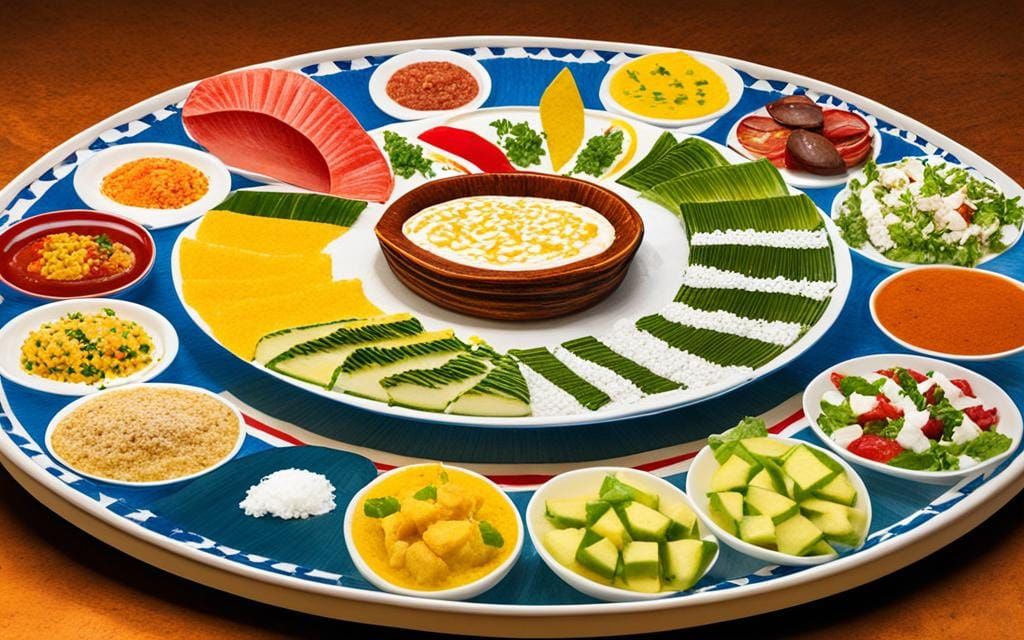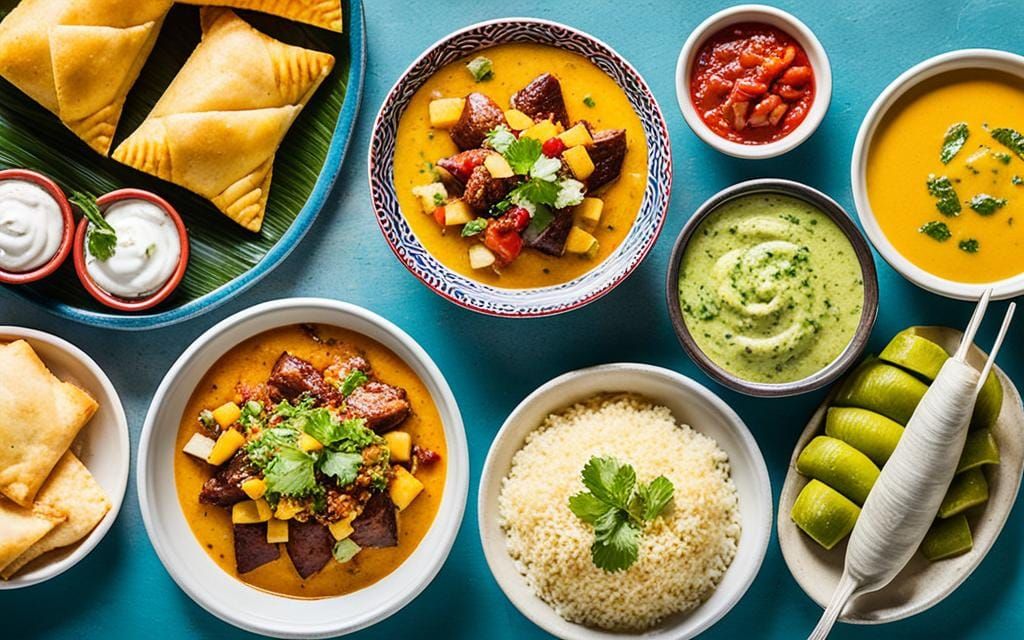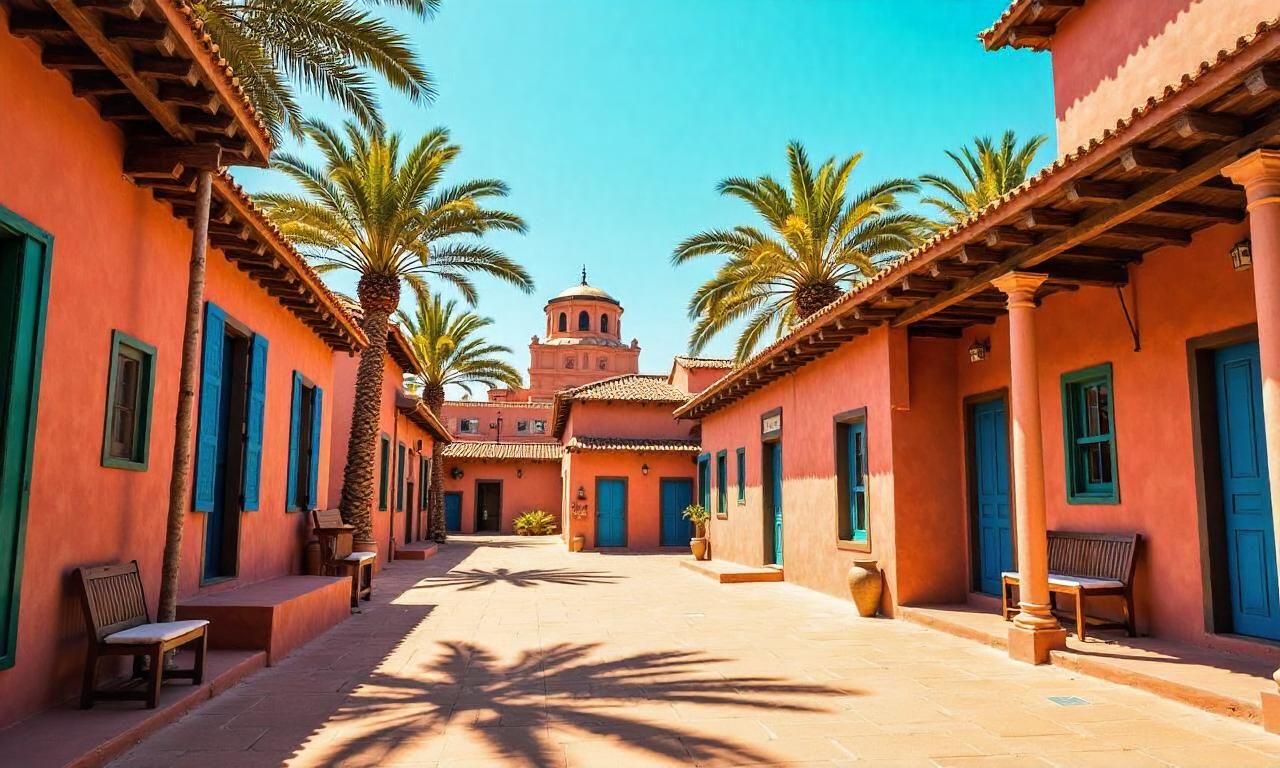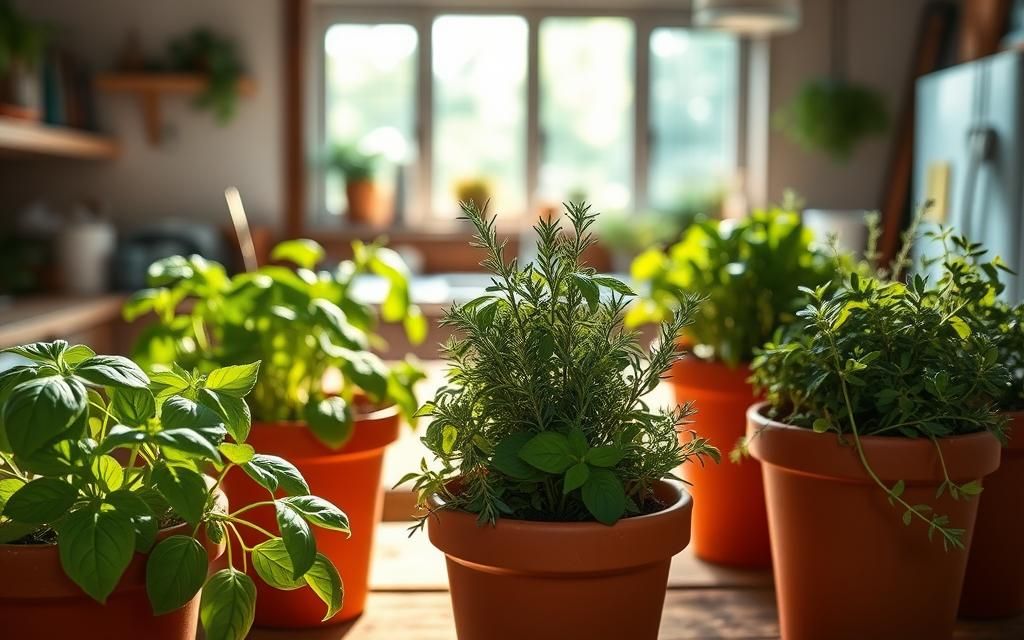Dominican Republic Food Culture – The Dominican Republic is a jewel in the Caribbean, known for its stunning beaches and rich landscapes. It boasts a unique dominican republic food culture that’s a mix of Taino, Spanish, African, and Middle Eastern influences. This blend creates dishes that are full of flavor and heartiness.
Table of Contents
ToggleAn Introduction to Dominican Cuisine
In the heart of the Caribbean is the Dominican Republic. It’s known for its lively culture and stunning views. But what stands out most is its rich culinary history. This history is a mix of influences from the Taino people, Spanish, and Africans. They all played a part in shaping the food we know and love today.
A Fusion of Flavors
Dominican food uses a lot of local ingredients. This includes tropical fruits, veggies, and fresh seafood. Mixing these together creates unique and delicious dishes. Dominican cuisine is all about combining flavors to make something special.
Indigenous, Spanish, and African Influences
A mix of cultures has influenced Dominican food. The Taino people started using local foods. Later, the Spanish brought new ingredients and cooking methods.
Finally, African culture added spices and cooking styles. This fusion of traditions has made Dominican dishes truly remarkable.
dominican republic food culture: Iconic Dishes to Savor
Let’s explore the incredible food scene in the Dominican Republic. It’s filled with traditional dishes that families have shared for years. These meals burst with color and taste, showing the heart of the country’s culture.
La Bandera Dominicana
The Dominican Republic’s famous “La Bandera Dominicana” dish is a must-try. It combines rice, red beans, and meat like chicken or beef. It’s named after the flag’s colors, showing true Dominican pride.
This meal takes you right to the core of Dominican life. Every bite is a fusion of local flavors and traditions. It’s a taste of their vibrant culture.
Sancocho
The cherished Sancocho stew is another masterpiece of Dominican food. It mixes various meats, root veggies, and spices. This creates a meal that comforts and fills your heart.
Eating this stew makes you appreciate Dominican creativity. It’s proof of how they blend different tastes with skill. You’ll love every spoonful.
Mofongo
Don’t forget the Mofongo, a dish with deep African roots. It features mashed plantains filled with pork, seafood, or veggies. The rich flavor and texture of Mofongo stand out in Dominican cuisine.
Eating Mofongo is like exploring Dominican history on a plate. It reflects the island’s varied influences. Each bite tells a story of the nation’s food culture.
Sweet Temptations: Dominican Desserts
Dominican cuisine is famous for its bold tastes. It’s no surprise the dessert scene matches that. With lots of tropical fruits and a rich food history, Dominican sweet treats are the perfect ending to any meal. The top ones are creamy flan and the cozy habichuelas con dulce.
Flan
Flan is a silky, custard-like dessert that all Dominicans love. It’s made from eggs, milk, and sugar — often with vanilla or caramel. This makes a rich, soft treat that’s just the right mix of sweet and custard. Flan is loved not just in the Dominican Republic but around the world. It’s a true symbol of Dominican food culture.
Habichuelas con Dulce
Habichuelas con dulce is a must-try if you’re exploring Dominican desserts. It’s made with red kidney beans, evaporated milk, and spices, plus tropical fruits. Which turns a basic food into a sweet, creamy delight. This dish really shows off Dominican creativity. Its unique mix of creamy beans and sweet sauce makes for a one-of-a-kind dessert. It’s deeply connected to Dominican food traditions.
Whether you choose flan or habichuelas con dulce, both are unforgettable. They offer a sweet end to your journey through the Dominican Republic’s lively food scene.
Dining Customs and Etiquette
Exploring the vibrant food culture of the Dominican Republic is a joy. Knowing, and respecting, the local dining customs and etiquette is key. This makes your eating experiences richer and shows you respect the locals and their traditions.
Being on time is very important in the Dominican Republic. Try to show up for meals right when they’re set. Meals are often about more than just food – they’re a chance to connect with others. Be ready for lively talks. Only sit when the host says so, and wait for them to start eating before you do.
When eating, use a knife and fork like many Dominicans do. Sometimes, for certain foods like yaniqueques and tostones, it’s okay to eat with your hands. Remember, it’s polite to keep your elbows off the table. Also, don’t speak with your mouth full.
For service at restaurants and when someone goes above and beyond, tipping is expected. The usual tip is 10-15% of the bill. This is a common way to show your appreciation.
As you dive deeper into the Dominican food scene, enjoy the friendly, welcoming spirit of the people. Connect with them, enjoy the tasty dishes, and explore the culture through food. It truly is a unique experience in the Caribbean.
Regional Variations in Dominican Cuisine
Exploring the Dominican Republic’s culinary world shows us its diverse menu which reflects its rich cultural history. From coastlines to the mountains, each part of this country shines with distinct food. The flavors are unique and promise a tasty journey for anyone.
Coastal Delicacies
Coastal areas like Punta Cana and Puerto Plata offer lots of fresh seafood. Imagine tasting ceviche, a dish where fish meets citrus in a burst of flavor. Or, enjoy the crispy delight of pescado frito, fried fish, paired with langostinos al ajillo, garlicky shrimp.
Mountain Specialties
Heading towards the heights, the Dominican Republic’s mountains serve up hearty meals. Try locrio de montaña, a flavorful rice dish with wild game or chivo guisado, a stewed goat known for its tenderness and delicious scent. These dishes show the countryside’s focus on its varied food culture.

Recommended Dining Experiences
To really get into the spirit of the dominican republic food culture, it’s great to visit local favorites. These places show off the tasty diversity of Dominican food. You might find hidden gems or famous spots that everyone loves.
Adrian Tropical
Adrian Tropical sits in Santo Domingo, offering true Dominican tastes for many years. This gem, run by a family, is famous for mangu. It’s a dish made of mashed plantains served with meat or seafood. The place feels welcoming and real, just like the culture it represents.
Boca Marina
In Puerto Plata’s boca marina, Boca Marina brings you the best of the coast. Enjoy dishes like ceviche and langostinos al ajillo. The food and the view of the sea make for a perfect meal. Don’t forget to try one of their fruity cocktails.
La Casita de Yeya
La Casita de Yeya is in Cabarete, offering a deep dive into the local cuisine. They’re known for their mofongo, a dish made from mashed plantains with meat or seafood. The place is cozy and filled with authentic flavors. It’s a highlight for anyone who loves food.
El Conuco
Creating hearty mountain cuisine, El Conuco is found in Jarabacoa. It serves meals like locrio de montaña and chivo guisado, representing mountain food traditions. Dining outside here lets you fully experience the cultural flavors of the Dominican Republic.
If you’re looking for a classic Dominican meal or new local dishes, these places are perfect. They’ll offer unique flavors that truly represent the dominican republic food culture.
Street Food and Local Favorites
Street food in the Dominican Republic is a big part of their food scene. It’s fun to try the small food places that you find everywhere. They serve tasty and local meals for low prices. You should try these favorites:
Yaniqueques
Yaniqueques, known as Dominican fritters, are very popular. These are bits of savory fried dough. They’re usually warm and might have cheese or meat inside. They make a great snack while you’re out exploring.
Tostones
Tostones are a must-try in the Dominican Republic. These are fried plantain slices, cooked twice. They’re seasoned with garlic, salt, and other spices. This makes them crunchy and tasty. They go perfectly with the local food culture.
While you’re out in the lively streets, try different foods. From the crunchy yaniqueques to the mouth-watering tostones. These local treats show the real heart of the Dominican Republic’s food scene.
Refreshing Dominican Beverages
While diving into the Dominican Republic’s food scene, you can’t miss the drinks. Try morir soñando and jugo de chinola. These beverages really show the heart of the country’s culture and are a great way to connect with the locals.
Morir Soñando
Morir soñando means “to die dreaming.” It mixes sweet condensed milk, zesty orange juice, and cool ice. This drink reflects the Dominican Republic’s lively nature, perfect for cooling off. It’s a sweet pause, letting you share in the island’s peaceful dreams.
Jugo de Chinola
Jugo de chinola is a vibrant beverage made from the chinola fruit, similar to passion fruit. This fruit adds a special tang to the Dominican juice. It’s an ideal partner for the country’s flavorful dishes, offering a sweet and tangy balance.
Don’t miss the chance to try Presidente beer; a light, crispy lager loved by many. And, fresh coconut water is there to quench your thirst. It highlights the island’s natural riches.
Exploring Dominican Republic’s Agricultural Treasures
The Dominican Republic is known for its exciting mix of farms. This variety has shaped the local food scene into what it is today. You’ll find the finest coffee, cacao (the source of chocolate), and rum here.
Coffee
Specialty coffee from the Dominican Republic is a world favorite. It thrives in the cool, mountainous areas. These places, like the Cibao Valley, grow top-grade arabica beans.
We can taste the best of Dominican coffee in its smooth, balanced flavor. It often hints at chocolate, caramel, and a soft sweetness. Coffee lovers worldwide appreciate these qualities.
Cacao
Cacao is the soul of chocolate, and the Dominican Republic is proud of its supply. It grows in the country’s warm, moist climate. This makes for cacao beans that are rich and full of flavor.
Dominican cacao is sought after by chocolate makers for its unique taste. The northern areas, with their lush cacao farms, show the care in growing this crop. These efforts sustain a tradition of exceptional chocolate making.
Rum
Rum is another star in the Dominican Republic’s farming story. Its distilleries have been making top-quality rum for a long time. The sugarcane fields around the island supply the essential ingredient.
This rum is loved for its smooth texture and taste, which can include hints of vanilla and tropical fruit. Enjoyed straight, mixed, or in a cocktail, it’s a key part of the country’s culture. It reflects its history and the craftsmanship of its rum makers.
Conclusion
Looking back on our trip through the dominican republic food culture, we’re fascinated. The mix of flavors, traditions, and unique dishes stands out. Each meal, from the filling mangu to the well-known la bandera, tells a story. It shares the deep cultural roots and the love that goes into cooking each dish.
Explored further, the dominican republic food culture shows its strength and creativity. Tasting the desserts like flan and habichuelas con dulce shows us this. They blend local, Spanish, and African tastes beautifully, showcasing the Dominican spirit.
Now, we say goodbye to this amazing journey but take much with us. We’ll always remember the friendliness and love in every meal. We urge you to keep on discovering the dominican republic food culture. It’s a direct path to the heart and spirit of this wonderful Caribbean country.
FAQ
What are some of the traditional dishes in Dominican cuisine?
Some iconic dishes in Dominican cuisine are la bandera, sancocho, and mofongo. La bandera is the national dish with rice, red beans, meat, and plantains. Sancocho is a hearty stew. Mofongo is mashed plantains mixed with garlic and pork.
What are some popular Dominican desserts?
Traditional desserts from the Dominican Republic often use tropical fruits. They include flan and habichuelas con dulce, which is a sweet red bean stew.
What are some local customs and etiquette to be aware of when dining in the Dominican Republic?
When trying Dominican food, start your meals with a small shot of mamajuana. This is a local herbal drink. Also, enjoy the lively dining atmosphere and the culture of eating food on the streets.
How does Dominican cuisine vary by region?
Coastal areas are famous for fresh seafood. Mountainous regions have dishes like locrio de montaña, a rice dish with wild game. They also eat chivo guisado, which is stewed goat.
What are some must-try Dominican street food favorites?
Yaniqueques are a favorite, which are fried dough fritters. Also, try tostones, which are twice-fried plantain slices.
What are some of the unique agricultural products that have influenced Dominican cuisine?
The Dominican Republic is famous for its top-quality coffee, cacao, and rum. These products have shaped the country’s deep culinary heritage.













